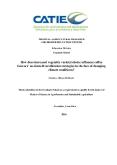Mostrar el registro sencillo del ítem
How does increased vegetable varietal choice influence coffee farmers’ on-farm diversification strategies in the face of changing climate conditions?
| dc.contributor.advisor | Van Zonneveld, Maarten | |
| dc.contributor.advisor | Solano, William | |
| dc.contributor.author | Hethcote, Lindsey A. | |
| dc.date.accessioned | 2017-02-22T21:16:14Z | |
| dc.date.available | 2017-02-22T21:16:14Z | |
| dc.date.issued | 2016 | |
| dc.identifier.uri | https://repositorio.catie.ac.cr/handle/11554/8523 | |
| dc.description | Tesis (M.Sc.) -- CATIE, Escuela de Posgrado, Turrialba (Costa Rica), 2016 | es_ES |
| dc.description.abstract | Crop diversification strategies are considered promising for Central American coffee farmers who are looking for solutions to confront rapidly changing climate conditions. Vegetable crops hold potential for diversification of coffee and other production systems because of their high potential for income and nutrition security. However, limited seed choice may lead to poor adaptation and eventually be a constraint to introducing these crops. We anticipate that with an increase in varietal choice of vegetable crops, farmers can make better choices when diversifying their farms, taking into consideration environmental and management conditions that lead toward more sustainable and intensified production. This study employs participatory evaluation with eight coffee farmers in Turrialba, Costa Rica, at two altitudes and under two different types of management (conventional and organic) as well as morphological characterization and evaluation of a diverse array of tomato and sweet pepper accessions and varieties (AVRDC varieties, CATIE accessions and commercial varieties) to determine whether increased varietal choice improves on-farm diversification strategies in the face of climate change. These accessions and varieties came from the CATIE genebank and the AVRDC breeding program, and their performance was compared to a few commercial varieties currently available in Costa Rica. Farmers’ scores from the participatory evaluation demonstrate that farmers identify a wide range of successful AVRDC varieties and CATIE accessions that score better for farmer-preferred traits compared with the standard commercial varieties. Both altitude and type of management influence farmers’ varietal preferences, illustrating the importance of increased varietal choice for coffee farmers growing in diverse environments. Characterization and evaluation data also shows a significant interactions between variety, altitude and type of management. A comparison of the most successful varieties defined by farmers and the most successful varieties according to characterization and evaluation data demonstrates that farmers often indicate varieties having the most potential to diversify farms that vary from those indicated in the agronomic evaluation. Without using participatory methods to include farmers’ preferences in varietal selection, varieties may be promoted that appear more satisfactory but are actually not preferred by farmers themselves. Farmers’ opinions in the present study illustrate that the current participatory evaluation of increased varieties was an effective tool to help identify several new varieties that have high potential for diversifying farms. | es_ES |
| dc.description.sponsorship | CATIE (Centro Agronómico Tropical de Investigación y Enseñanza) | es_ES |
| dc.language.iso | en | es_ES |
| dc.publisher | Centro Agronómico Tropical de Investigación y Enseñanza (CATIE) | es_ES |
| dc.rights | info:eu-repo/semantics/openAccess | |
| dc.subject | COFFEA | |
| dc.subject | AGROFORESTERIA | |
| dc.subject | AGROBIODIVERSIDAD | |
| dc.subject | CULTIVOS | |
| dc.subject | DIVERSIFICACION | |
| dc.subject | VARIEDADES | |
| dc.subject | MANEJO DEL CULTIVO | |
| dc.subject | HORTALIZAS | |
| dc.subject | RECURSOS GENETICOS VEGETALES | |
| dc.subject | CAMBIO CLIMATICO | |
| dc.subject | COSTA RICA | |
| dc.subject | AMERICA CENTRAL | |
| dc.title | How does increased vegetable varietal choice influence coffee farmers’ on-farm diversification strategies in the face of changing climate conditions? | es_ES |
| dc.type | Tesis de maestría | es_ES |
Ficheros en el ítem
Este ítem aparece en la(s) siguiente(s) colección(ones)
-
Tesis [2889]


